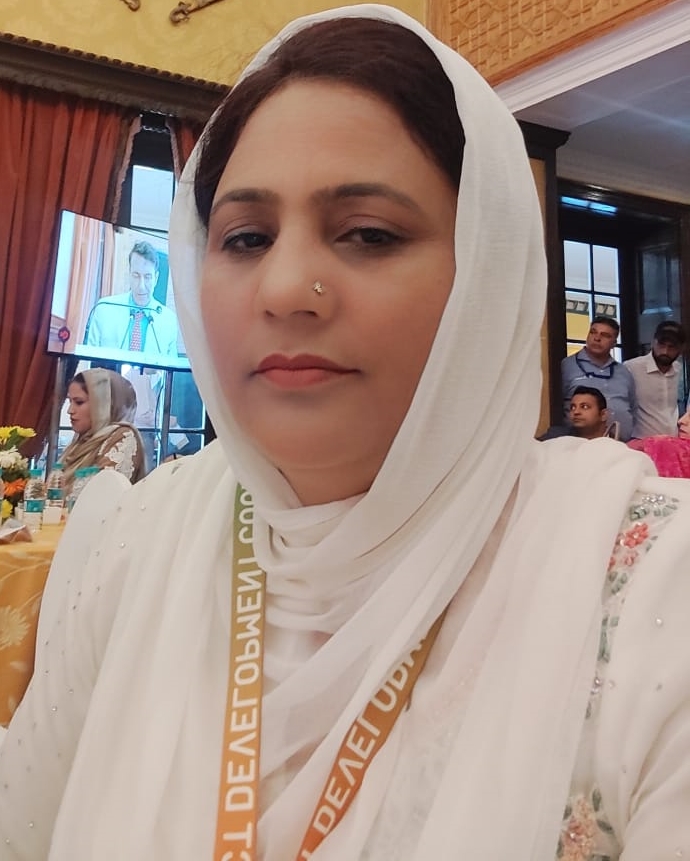
 JAMMU: In an insightful and candid conversation, Ajmer Alam Wani, Editor-in-Chief of JK Monitor (www.jkmonitor.org), had the privilege of conducting an exclusive online interview with Dr. Shamshad Shan, the Chairperson of the District Development Council (DDC) in Ramban, a remote and hilly region nestled in the heart of the Union Territory of Jammu and Kashmir. Dr. Shan, an ardent advocate for progress and change, shed light on the myriad challenges faced by District Ramban and the urgent need for governmental intervention to uplift its education, healthcare, infrastructure, and basic amenities sectors.
JAMMU: In an insightful and candid conversation, Ajmer Alam Wani, Editor-in-Chief of JK Monitor (www.jkmonitor.org), had the privilege of conducting an exclusive online interview with Dr. Shamshad Shan, the Chairperson of the District Development Council (DDC) in Ramban, a remote and hilly region nestled in the heart of the Union Territory of Jammu and Kashmir. Dr. Shan, an ardent advocate for progress and change, shed light on the myriad challenges faced by District Ramban and the urgent need for governmental intervention to uplift its education, healthcare, infrastructure, and basic amenities sectors.
Dr. Shan began by underlining the stark reality that District Ramban stands at the crossroads of development and disparity, grappling with the lowest literacy rate in the entire Union Territory.
With an unwavering commitment to education, she emphasized that concerted efforts must be made by the government to funnel resources into the education sector. According to her, while the district boasts an adequate number of schools, the lack of infrastructure and manpower has severely hindered the sector's growth, leaving its potential untapped.
However, education is just the tip of the iceberg. Dr. Shan painted a vivid picture of the pressing challenges plaguing District Ramban. She lamented the acute shortage of accommodation in educational and healthcare institutions across rural areas. Despite the presence of schools, colleges, and health centers, the deficiency in infrastructure and personnel has resulted in a distressing state of affairs, leaving these vital institutions struggling to provide quality services.
The energy sector also remains a thorny issue for the district. Dr. Shan highlighted the persistent problems within the rural electric department, where faulty systems, inadequate wiring, and improper poles have culminated in recurring power curtailments in the rural areas of District Ramban. This impediment has not only hampered daily life but also cast a shadow on the prospects of economic growth and prosperity.
Furthermore, the lack of access to safe drinking water emerged as a glaring concern. Dr. Shan pointed out that numerous habitations and hamlets within District Ramban still lack access to clean and safe drinking water. The absence of this basic necessity has implications far beyond inconvenience, affecting the health and well-being of the local population.
In the context of District Ramban's unique geographical challenges, Dr. Shan highlighted the unforgiving winter conditions that the region endures. Being a hilly and landslide-prone area, the district faces significant hurdles in maintaining connectivity, with certain areas remaining cut off from road access during the winter months. Dr. Shan vividly described the plight of residents who have to traverse distances of 3 to 5 kilometers on foot to reach the nearest road, exemplifying the dire need for improved infrastructure and accessibility.
On a broader administrative note, Dr. Shan expressed her concern about the lack of an effective tendering process, which has resulted in underutilized funds. She stressed that the dearth of proper infrastructure and manpower across various government departments has impeded the effective implementation of government schemes, preventing them from making a tangible impact on the ground.
As the interview drew to a close, Dr. Shan's passion and dedication to her community were palpable. She emphasized that the main hurdle faced by District Ramban is the insufficiency of infrastructure and human resources in every department. Her resounding call to action is for the government to prioritize the district's development and channel its efforts towards transforming the challenges into opportunities, ultimately propelling District Ramban towards a brighter and more prosperous future.
For the detailed interview, read questions and answers below till end:-
- Can you provide an overview of the current state of rural development in the Ramban district? What are the key areas that require immediate attention and improvement?
Ans: Since District Ramban is a hilly and remotest District of UT of Jammu and Kashmir where there is the lowest literacy rate and I feel lowest number of local employees also. Regarding rural development, in District, Ramban there are two National Projects underway and near completion one is National High Way Authority of India and other is Northern Railways, by virtue of which the roads in the area where these projects are under process have got the connectivity and in other rural areas, still three is not proper road connectivity and needs further attention by the Government.
Regarding other infrastructure there is acute shortage of accommodation in Educational Institutions, Health Institutions in rural areas. Here in District, Ramban there are sufficient number of schools in the District, but lacks infrastructure and manpower due to which the Education Sector is facing badly and same is the case in Health and other Departments also.
However the Government is releasing funds under various heads, but due non availability of proper mechanism for utilization of the same leads to lapse of funds and maximum number of works either remained untouched or incomplete.
During the month from November to March in hilly areas of District, Ramban no work is being executed due to snowfall. As such only seven months remain for the execution of work and the delay process also shortcuts the time line of the completion of the project.
- How has the education sector in the district progressed in recent years? Are there any initiatives or programs aimed at improving the quality of education and increasing access to education for rural communities?
Ans: In District Ramban there are 872 schools among which there are 22 Higher Secondary Schools, 68 High Schools,253 Middle Schools, 525 Primary Schools, 04 KGBV and one JNV But each in every school there is shortage of Teaching as well as non teaching staff. Besides there is shortage of infrastructure also. Government during last four years has taken various steps for upliftment of the Education Sector which includes establishment of Kindergarten in various schools engagement of 84 AAYAs/Helpers in these Kindergartens, besides the construction of various new school building in which the building of Higher Secondary School Tetharka is under construction.
In view of lowest literacy rate in District Ramban in whole UT of J&K, there is dire need that Government shall focus on the Education Sector in District, Ramban. Regarding quality Education it is pertinent to mention that there are 05 posts of Principals, 21 posts of Headmasters, 02 Posts of ZEPOs, 137 posts of Lecturers, 265 posts of Masters and 268 posts of teachers vacant in District Ramban and as such how it is expected that due to such huge vacancy in the Education sector it is possible to provide quality Education to the students.
Regarding access of Education to the students in rural areas, the schools under SSA Scheme at Primary level were opened and I feel that enough schools were opened and there is sufficient schools at Primary Level to cater the need of the students of rural areas of District Ramban. But there is dire need of upgradation of schools to the level of High and Higher Secondary Schools as there is at various places students have to travel distance of 30 kilometers to reach nearest Higher Secondary School.
On National Highway there is only one Higher Secondary School i.e HSS Ramban and there is no Higher Secondary School near National Highway from Ramban to Banihal. Due to non availability of Higher Secondary Schools at feasible places maximum number of students especially girl students left their studies after 10th Class and the same case is for High Schools, as the students have to travel a distance of 2 hours to reach the nearest High School to get themselves admitted in 10th Class.
For example there are areas in Zone Ramban like Gugwal, Khatter, Khariel the students of the said area has to travel a distance of 2.5 hours to reach nearest High School i.e GHS Ramban or HSS Ramban, as such maximum number of students especially girls left the Education after passing 6th Class.
As such there is dire need of up gradation of schools in District Ramban as per feasibility from MS to HS and HS HSS. Besides there is dire need of filling up of and Creation of new posts in Education Sector in District Ramban in order to enhance the literacy rate.
- In terms of electricity infrastructure, what steps have been taken to ensure reliable and uninterrupted power supply to both urban and rural areas in Ramban? Are there any plans for renewable energy projects or electrification of remote regions?
Ans: Regarding electricity there is still faulty system in Electric Department in rural areas of District Ramban. There is no proper wiring and proper poles in rural areas of District, Ramban due to which there remains power curtailment in the rural areas of District Ramban. To some extent there is power supply in Urban areas of District, Ramban but no uninterrupted but with SLDC Cuts. There is dire need of up gradation grid stations and creation of new grid stations in District, Ramban. Furthermore there vis already the construction of Sawlakote Hydro Electric Project is at infancy stage and will be biggest Power Project in Asia and after its augmentation there will be quite sufficient power supply to District, Ramban. It is pertinent to mention here that there is already 550 MW Bhagliar Hydro Power Project working in District, Ramban.
- What is the status of road infrastructure in the district? Have there been any notable developments in terms of improving connectivity between rural areas and urban centers? Are there plans to address the challenges faced by remote villages with regard to road connectivity?
Ans: Since in the District various new roads are under construction under various schemes and after completion of these roads most of rural areas of District Ramban will be connected with the other areas of District Ramban.
Since PMGSY and PWD are already executing various roads and the out of DDC/BDC grants various roads were taken up and are under construction. Due to late tendering process the execution of various roads cannot be completed in time and funds earmarked for the same are lapsed.
There is no proper system of tendering process due to which the whole funds could not be utilized. In District Ramban various area are still cut off from the road connectivity and has travel distance of 3 to 5 kilometers on foot to reach the nearest road. Government needs special attention in order to redress the issue regarding road connectivity to the rural areas of District Ramban.
- Access to clean and safe drinking water is crucial for rural communities. Could you highlight any initiatives or projects undertaken to improve water supply infrastructure in Ramban? What steps are being taken to address water scarcity and ensure quality water for all residents?
Ans: Regarding safe drinking water various habitations and hamlets are still uncovered with safe drinking water in District Ramban. In view of implementation of Jal Jeevan Mission Schema all the uncovered habitations will be covered under safe drinking water facility in District, Ramban.
- Food security is an important aspect of rural development. What measures are being implemented to enhance the food supply chain in the district, particularly for marginalized communities? Are there any plans for promoting sustainable agriculture and supporting farmers?
Ans: According to the Global Food Security Index 2022, India has a prevalence of under nutrition of 16.3%. Agriculture is essential in ensuring food security goal. In District Ramban various schemes in Agriculture sector are under way for achieving the food security in the rural as well urban areas of District, Ramban.
- What is the current economic status of the district, and what efforts are being made to promote economic growth and generate employment opportunities for the local population? Are there any plans to attract investment or support entrepreneurship in Ramban?
Ans: Current economic condition of the District Ramban is not so good as compared to other Districts of UT of J&K. Since in District, Ramban two National Projects are under construction i.e National Highway and Railway, some of the locals were engaged in these projects and as such feel a sigh of relief.
The concessionaire companies working under these projects do not prefer the local employment and as such due to the same District, Ramban has not got the huge benefit of the same. District Industries Center, Ramban is implementing the schemes to support entrepreneurship in Ramban.
Besides various Tourism Festivals were organized in District at various places for promoting the tourism in the District. District Ramban having huge potential of tourism havin scenic beauty of various places bestowed with natures wild verities of flowers, pine forests and breath taking Meadows. District Ramban gets meager capex funding as compared to other district and needs to be divided in clusters for better funding and tourist attraction.
- Winter challenges, such as extreme weather conditions and limited accessibility, can significantly impact rural communities. How does the district administration address these challenges and ensure the well-being of residents during the winter season?
Ans: In fact there are huge winter challenges in the District being hilly and sliding prone District. Whether condition and limited accessibility significantly impact the rural areas during the winter. District and Tehsil Level Administration play an important role to redress the grievances of the inhabitants of the rural areas during the winter by way of deploying machines for clearance of roads, keeping the advance stock of food, medicines, fuel and other eatable items. Further the teams are constituted besides the Emergency Operation centers are being established at District and Tehsil Level during the winters.
- What role does agriculture and horticulture play in the district's economy? Are there any initiatives or schemes aimed at supporting farmers, enhancing productivity, and promoting sustainable farming practices?
Ans: All the schemes of Agriculture and Horticulture are being implemented in the District Ramban by the concerned departments for uplifment of farmers. Enhancing productivity and promoting sustainable farming practices are being implemented in the District.
- Social welfare programs are essential for the upliftment of marginalized communities. Can you elaborate on the social welfare initiatives and schemes implemented in Ramban to address issues like poverty alleviation, women empowerment, and inclusive development?
Ans: Various schemes under Social Welfare Sector in District, Ramban are being implemented including old age pension, Scholarship to the students, Marriage assistance besides Motor Bikes are being provided to disabled persons through Social Welfare Department. In District Child Welfare Society, Justice Juvenile Board and Old Age Home is functional. Alleviation women empowerment schemes in the District under social welfare department are also under way.
- Lastly, what are the key problems and challenges faced by the district in terms of rural development? How do you plan to overcome these challenges and achieve holistic growth and progress in Ramban?
Ans: Being the District hilly and keeping in view the topography main problem is inadequate infrastructure and manpower in each and every department due to which all the schemes of the Government are not implemented on ground in true spirit.




